Authority Soccer (authoritysoccer.com) is a participant in the Amazon Services LLC Associates Program, an affiliate advertising program designed to provide a means for sites to earn advertising fees by advertising and linking to Amazon.com. This site also participates in other affiliate programs and is compensated for referring traffic and business to them.
Are you having issues gathering enough players for a game of soccer? Is it too cold or too hot outside to play?
Whether you despise playing soccer outdoors in the cold or during the hot months or you can’t seem to gather enough people for a regulation soccer game, indoor soccer is the answer to all of your problems.
Perfect for staying in shape during the winter months, this game can be played with 5-7 people per side, including the goalkeeper.
As opposed to what many people think, indoor soccer is not the same as futsal. Even though both variations of soccer are played indoors, futsal is played on wooden or ceramic surfaces, while indoor soccer is typically played on synthetic turf or synthetic carpet.
This sport is played in several amateurs, collegiate, and professional leagues in the US and Canada.
If you’re reading about it, you must be interested in indoor soccer. Get excited, because we’re about to reveal some of the best strategies, formations, tips, and drills that can help you bring your indoor play to the next level. Enjoy the reading!
Indoor Soccer Strategy 6v6
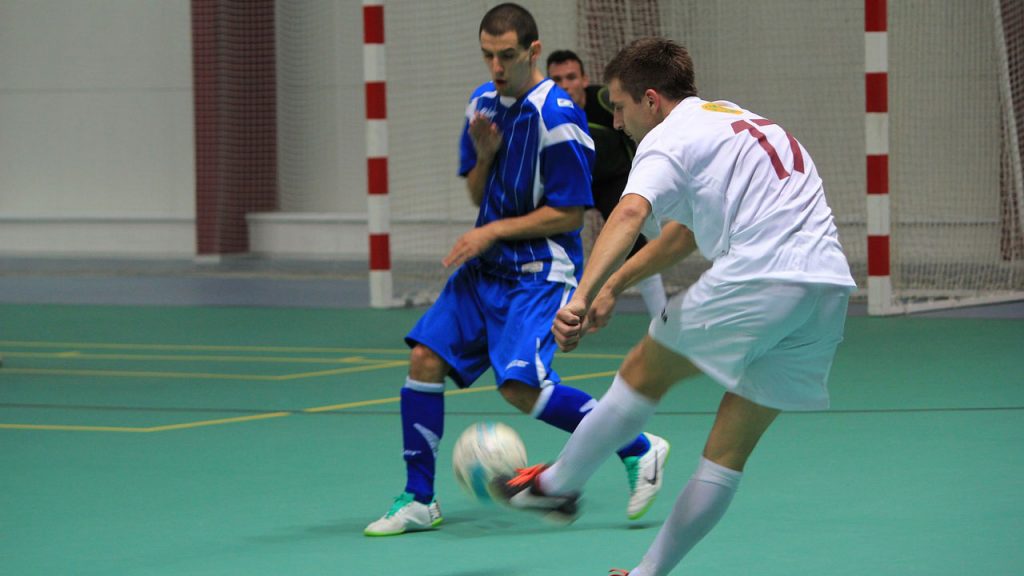
Soccer is known as a methodical game, however, with indoor soccer things are a bit different and can get even more complex.
Indoor soccer is a fast-paced game that requires a ton of team coordination. While there are strategies that the teams can utilize, playing together and developing team chemistry is what leads to wins.
Let’s take a look into some of the strategies that 6v6 indoor soccer teams can use to their advantage:
1. The passing strategy
Moving the ball from player to player is the best way to keep position and open up the scoring chances in indoor soccer. Playing solo and trying to dribble around everyone almost never works in the small pitch conditions.
This is probably why most teams play the passing game. For experienced teams and players, the one-touch offense is the strategy of choice.
To stop these indoor soccer strategies in their tracks, the opposing team needs to shift its strategy to a more defensive one, which ruins their chances of scoring.
2. Counterstrike offense
Counterstrikes are how most goals are scored in indoor soccer. Sending the ball forward as soon as you’re in position is almost always a safe bet.
However, sometimes counterattacks are difficult to pull off. Knowing when to deploy this strategy is important and it’s one of those things that comes with trial and error.
Typically, when the opposing team is playing with more attackers than you is when this strategy should be whipped out.
3. The planted player strategy
This is a strategy that works for both the offensive and defensive end of the game. It is based on keeping one player constantly in the same position.
For offense, this strategy enables the team to always have one player in a counterattack position, while sacrificing a little on the defensive end.
In defense, the planted player strategy ensures that there’s always at least one person left behind to help the goalkeeper with defending the goal.
4. The all-in strategy
Here’s another strategy that can be applied both to the defense and offense in indoor soccer.
On the offensive end, this strategy involves all of the team’s players moving forward with the ball in order to score. We use this tactic in desperate situations when our team is behind and needs to score a lot of goals to catch up.
On the defensive end, all of the players are moved back to defend. This defensive strategy is used when our team is ahead and we want to save the lead until the game time runs out.
5. Wing play
Playing the ball wide on either side of the field is sometimes the best strategy to call in a game.
Commonly used in regular soccer, the wing play strategy relies on exploiting the weakness in the opponent’s defense, especially when they’re running a more offensive formation. You can read more on that in the next section of the text.
Best Tactics and Formations for Indoor Soccer
With all of the winning strategies explained, the time has come for us to reveal the most popular, as well as the most effective, indoor soccer tactics and formations.
In addition to 6v6 indoor tactics and formations, we’ll take a stroll through the most popular 5v5 and 7v7 indoor soccer formations. Here’s the list:
1. Playing the 2-2-1 formation

This might be the most popular 6v6 soccer formation. With two defenders, two midfielders, and one attacker, this indoor soccer tactic ensures that your goal remains safe while sacrificing a little on the attacking end of the game.
The one weak point of this tactic is that midfielders can easily overstep into offense, which can lead to a counterattack.
2. Playing the 2-1-2 formation

Here’s another popular tactic employed in 6v6 soccer. This time around, the formation is more attack-oriented, with two defenders, a single midfielder, and two attackers.
The midfielder acts as a link between the offense and the defense, providing help on both ends of the field.
For this reason, commonly the best player in the team holds this spot, as a simple mistake on their end can lead to a counterattack.
3. Playing the 3-1-1 formation

At the first glance, this formation seems like a mistake; having three defenders doesn’t seem like a fun way to play soccer.
However, this tactic relies on both wing defenders moving forward to join the attack. When the ball is on the left side of the field, the right defender should be moving to the attacking side of the field while the left defender stays behind and vice versa.
Once again, the midfielder is the key element of the formation: They are in charge of dictating the tempo of play as well as creating space for the defenders to move forward.
Of course, there’s a version of this tactic when the defenders don’t move forwards and it’s used when the team doesn’t want to be on the receiving end of any more goals.
4. Playing the 1-3-1 formation
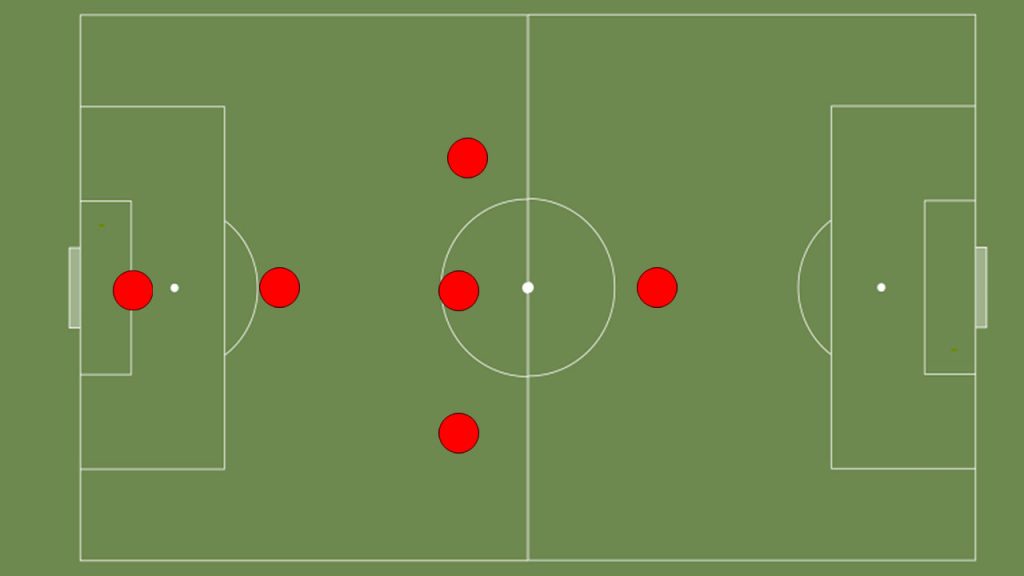
Commonly disregarded, the tactic in which three midfielders work on both sides of the field is one that you should pay attention to.
This formation provides width and cover in the central area of the field, which is something that all previously listed tactics lack.
The main disadvantage to this tactic is obvious; there’s only a single defender to take care of any potential mishaps upfront. This is why the three midfielders need to be confident and strong players for this tactic to work.
5. Playing the 1-2-1 formation
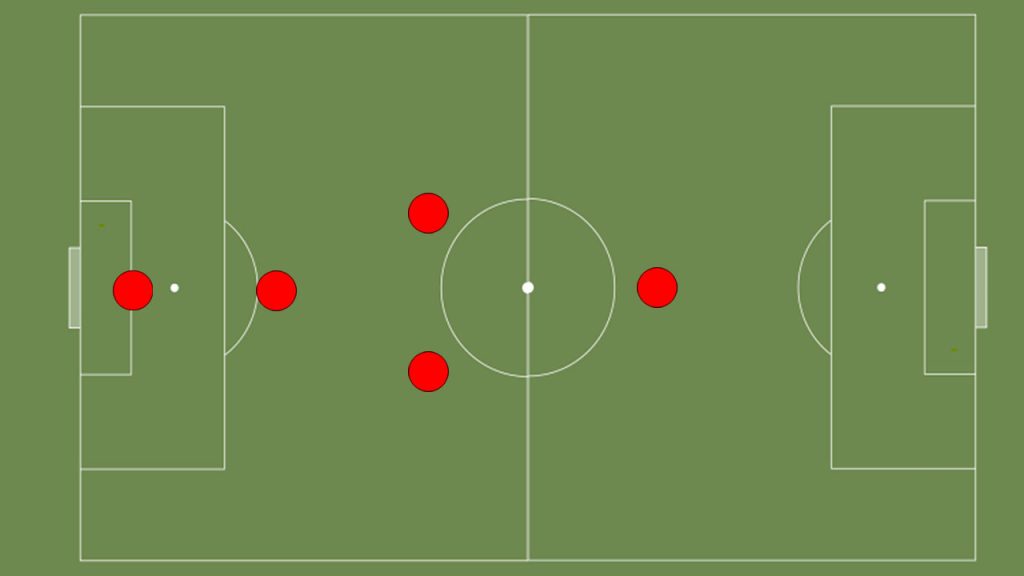
Here’s a formation for those who prefer 5v5 indoor soccer: This one’s commonly referred to as the diamond tactic and it is the most commonly used formation in this type of soccer.
Coaches and players agree that it provides the perfect balance between offense and defense, with two midfielders moving to both sides of the field as needed.
Once again, the midfielders need to be strong, fast, and able to withstand the pressure that comes with playing with a single defender.
6. Playing the 2-3-1 formation
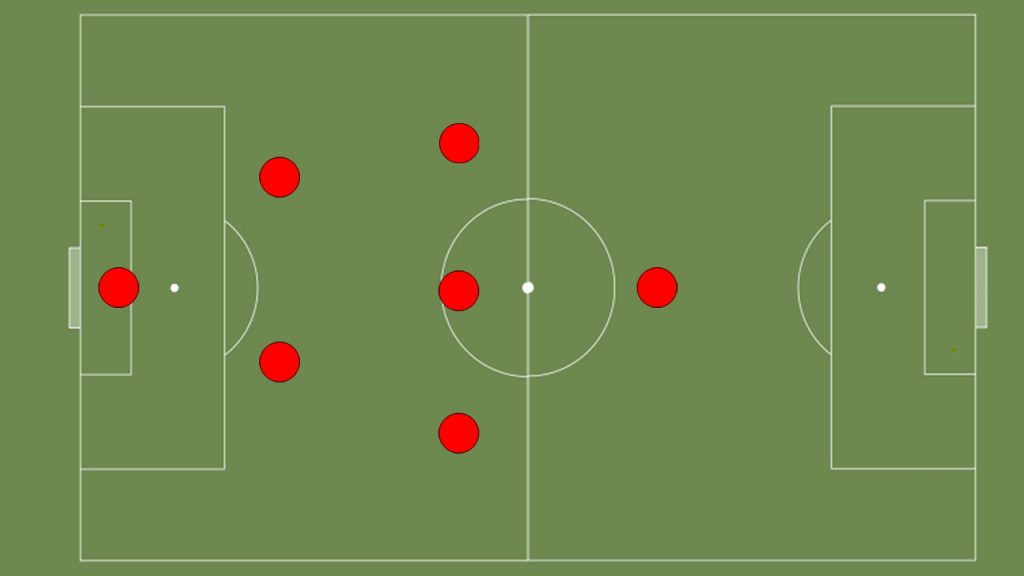
Here’s one for the 7v7 indoor soccer enthusiasts: Playing with this many players means that compromises on one end of the field are not necessary.
The 2-3-1 formation offers an excellent balance between defensive ability and midfield control, with some scoring potential. With this tactic, both wing midfielders are expected to take charge in the offense, while the middle midfielder mostly strolls back to defend.
This is the most effective 7v7 soccer formation, both in defensive and offensive terms.
Indoor Soccer Tips

In a fast-paced game such as indoor soccer, keeping your head straight is the key. Sometimes all of the strategic agreements that you’ve previously made fall into the water as soon as the game starts.
Here are the 10 indoor soccer tips that can prevent this from happening:
1. Don’t pass backward at kick-off
Playing the regular 11v11 soccer, most players are used to passing the ball backward at kick-off. In indoor soccer, players need to keep in mind the length of the field.
As the field is much shorter, passing the ball back is guaranteed to turn your offense into defense. To prevent this, indoor soccer players should wait for teammates to go to the attacking side of the field before passing the ball.
2. Keep the ball low
In indoor soccer, the ball travels much faster than it does in regular association football. This also means that it bounces harder. For these reasons, the ball should be kept low when passing, with some added topspin to improve the pass accuracy.
3. The attacker always stays on the opponent’s side
Remember that there’s no offside rule in indoor soccer. This is why the attacker should be on the opposing team’s half for the majority of the game, waiting for a counterattack chance.
This, however, doesn’t mean that they shouldn’t help with defense when necessary.
4. Have good substitutes
As mentioned multiple times throughout this text, indoor soccer is a fast-paced game. Due to the constant running, players can rarely withstand playing the entire game to their fullest ability.
This is where substitutes come in; make sure that these players are as good as the starting ones or better than them in order to maintain the pace of the game or even improve it.
5. Don’t yell out your teammates’ names when asking for the ball
This tip applies even to amateur indoor soccer play: Never call your teammate’s name when asking for the ball as it can draw attention from the opposition.
Instead, you should agree on a signal before the game starts. Commonly a raised hand is more than enough to increase your team’s effectiveness and reduce the chance of the other team discovering what you’re up to.
6. Don’t pass the ball directly
Passing the ball directly into your teammate’s feet is never a good idea, especially in a fast game such as indoor soccer.
Instead, players should make a habit of passing into space where their teammate is most likely to obtain possession.
7. Don’t hold on to the ball for too long
This is a rule that can be applied to goalkeepers and all other players on the field. Holding on to the ball is almost never a good idea on small soccer fields as the opposing team can reach you in seconds.
After a save, goalkeepers should ensure that the ball is moved forward quickly in order to start a counterattack.
8. Avoid unnecessary moves in front of your own goal
Flashy dribbles and risky passes in front of your own goal should be avoided at all costs as they can turn ugly in a second.
Make sure that all of your defensive passes go to the same side of the field you’re on and avoid sending the passes from side to side in front of your own goal.
9. Utilize the walls
Most indoor soccer matches are played on a field that has some sort of a side barrier that can be utilized in play. If you can’t get the ball directly to a teammate, try bouncing it off the wall to them.
You can also use the wall to pass the ball to yourself this way. Make sure to practice beforehand, as getting the right angles can be tricky.
10. Get the right ball
Due to the difference in field material, indoor soccer balls are built differently compared to standard soccer balls. If you’re getting into indoor soccer, investing in a ball designed specifically for it is one of the best tips we can provide.
Indoor Soccer Drills
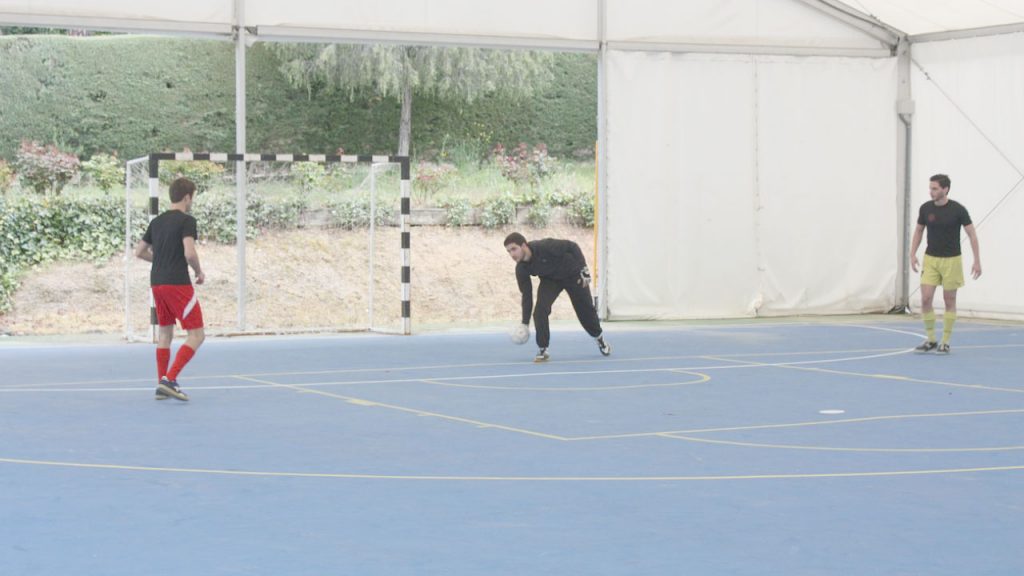
After going through the extensive list of strategies, tactics, formations, and tips for indoor soccer, we’ve come to the final section of this article.
This section is dedicated to improving your indoor soccer skills. Here are some of the drills that can help with that:
1. The Wall
In order to be able to go around an opponent by passing the ball to teammates or yourself using the wall, you’re going to need a lot of practice.
All you need for this drill is an indoor soccer ball and a wall. Practice bouncing the ball at different angles so that nothing can surprise you when it’s game time. Remember, the wall can be your best teammate in a game.
2. The Bouncing Strike
Here’s an indoor soccer drill that builds on the previous one. This time, it involves two players.
The first player bounces the ball off the wall, while the other player has to score with just a single touch once the ball reaches them.
This drill builds confidence and skill by bouncing the ball off the barrier for both the sending and the receiving player.
3. The Cone Strike
Every player is a striker in indoor soccer. This is why this is one of the most important drills that you can run with your team.
Set up as many cones as you can get around the pitch. Every player should have their own ball for the drill. After the coach sounds the whistle once, all players sprint, leading the ball between the cones until the coach blows the whistle again.
Here’s where the fun begins: with two consecutive whistles from the coach, the players need to turn in the opposite direction together with the ball.
Then the coach calls one player’s name and that player has two touches to set up their shot towards the goal. The coach can choose to call multiple names or none in order to keep the players on their toes.
4. The High Ball Catch
Due to the surface difference, the ball bounces much higher on indoor pitches than it does on regular outdoor soccer ones. This is why we recommend passing the ball low.
However, high balls can come at you unexpectedly. This drill teaches you how to deal with this issue and improve both your passing and receiving skills.
Determine a line, set the cone there, and have one player line up five feet behind it. The coach or another player should stand 5-10 feet on the opposite end of the cone and bounce the ball off the field so it reaches the first player and their waist to chest height.
The player then needs to move forward and bring the ball down with their chest and then pass the ball back to the, while making sure that they haven’t crossed the line and the cone.
5. The Fast Pass
Set up as many cones as you can in the middle of the field (five or more recommended). Two players should stand on either side of the cones, around 7 feet away from them.
The ball should be passed between the players while moving from the first to the last cone, never passing through the same gap.
As the players’ skills advance, increase the speed of movement and the number of cones. This drill is an excellent way to quickly adapt to the quick passing that is necessary for indoor soccer.
We’ve gone through all of the key strategies, formations, tips, and drills for indoor soccer. All that’s left now is to go and play.
You can check out our article 3 v 3 Soccer Strategy, Tactics, Tips, and Drills.
